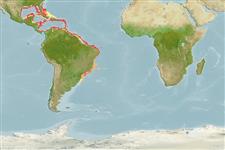Common names from other countries
>
Perciformes/Serranoidei (Groupers) >
Anthiadidae (Fairy basslets or Streamer basses)
Etymology: Pronotogrammus: Greek, pro = first, in front of + Greek, noton = back + Greek, gramma = signal, letter (Ref. 45335).
More on author: Guichenot.
Environment: milieu / climate zone / depth range / distribution range
экология
морской демерсальный; пределы глубины 65 - 230 m (Ref. 34841). Tropical; 32°N - 36°S
Western Atlantic: Florida, USA and Bermuda through the Greater Antilles to Rio Grande, Brazil (Ref. 47377).
Size / Вес / Возраст
Maturity: Lm ? range ? - ? cm
Max length : 20.0 cm TL самец/пол неопределен; (Ref. 7251); common length : 16.0 cm TL самец/пол неопределен; (Ref. 5217); наибольший возраст (опубликованны данные): 15 годы (Ref. 96848)
колючие лучи спинного плавника (общее число) : 10; членистые (мягкие) лучи спинного плавника (общее число) : 13 - 16; колючие лучи анального плавника: 3; членистые (мягкие) лучи анального плавника: 7 - 8; позвонки: 26.
Adults are commonly found on outer continental shelf reefs. They primarily feed on zooplankton while common in the diet of larger predators like snappers and groupers (Ref. 96848).
Are monandric (males are secondary), protogynous hermaphrodites. About 50% of females transform into males at 7.63 cm SL and 1.0 yr of age (Ref. 96848). During the spawning period, oocytes are found to be in different stages of development indicating asynchronous oocyte development and indeterminate fecundity (Ref. 96848).
Anderson, W.D. Jr. and P.C. Heemstra, 1980. Two new species of Western Atlantic Anthias (Pisces: Serranidae), redescription of A. asperilinguis and review of Holanthias martinicensis. Copeia 1980(1):72-87. (Ref. 34841)
Статус Красного Списка МСОП (Ref. 130435)
CITES (Ref. 128078)
Not Evaluated
Угроза для людей
Harmless
Использование человеком
рыболовство: интереса не представляет
дополнительная информация
инструменты
Специальные отчеты
Скачать в формате XML
ресурсы в Интернет
Estimates based on models
Preferred temperature (Ref.
115969): 17.3 - 25.8, mean 21.2 (based on 86 cells).
Phylogenetic diversity index (Ref.
82804): PD
50 = 0.6250 [Uniqueness, from 0.5 = low to 2.0 = high].
Trophic level (Ref.
69278): 3.5 ±0.5 se; based on size and trophs of closest relatives
устойчивость к внешним воздействиям (Ref.
120179): средний (среднего размера), минимальное время удвоения популяции 1.4-4.4 года (Preliminary K or Fecundity.).
Fishing Vulnerability (Ref.
59153): Low vulnerability (22 of 100).
